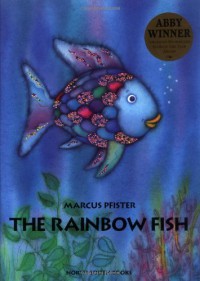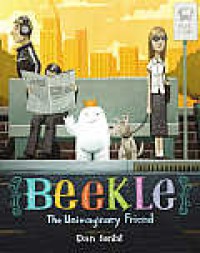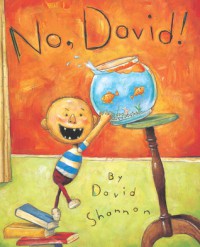The Rainbow Fish

Grade: 1st
This book is all about friendship. The Rainbow Fish gives away all his scales. At the end of the book, he may not be as beautiful as he once was, but he now has many friends. I will read this book to my classroom to promote friendship. We will discuss what a good friend is and why it is important to be a good friend. Then, each student will get a scale. They will write one or two words describing what a good friend is. Afterwards, we will make a Rainbow Fish. If I see students not being a good friend, we will refer to the fish to evaluate our actions. This is a good way to hold students accountable for their actions since they are the ones that came up with the traits of a good friend.
Frindle

Grade: 5th
I love Andrew Clements and Frindle! This is a story about how a boy makes up a new word for pen. I will do a novel study with this book in my class. This is a great book to get students creativeness flowing. We will intertwine this lesson with how to use a dictionary. Throughout the story, we will do different activities. For one, they will make up a new word for an object just as the boy in the story did. They will create a dictionary entry for their word. They will include things such as the old word, the new word, a picture of the word, how to pronounce the word, the part of speech, other forms of the word, the definition, synonyms, and an example of the word in a sentence. They will also create an advertisement to sell their newly named product. They will also write a newspaper article about how their new word has been a huge hit worldwide. They will include why they chose the word, what the word means, and what the success of the word being put in the dictionary means for them.
Werewolves Don't Go to Summer Camp

Grade: 4th
This story is about a camp counselor at Camp Lone Wolf. The kids in the story become suspicious of him being a werewolf after he eats his meat raw, is hair like a wolf, and is obsessed with wolves. I will read this story aloud to my students as part of a classroom management strategy. Whenever the class as a whole receives 25 gum balls in the class gum ball machine for good behavior, they will get to choose a book a reward. For this "book and a reward," we will read this story aloud as a class during read aloud time. When we finish it, the class will get to have a "Reading Camp" as their reward. They will bring sleeping bags and books to read for the day. They will present their favorite book to the class as part of the day, and they will also write a story about a time they went to summer camp and had a camp counselor that was some other type of character instead of a werewolf. Students will get to sit around a pretend campfire with a flashlight and read their story.
Werewolves Don't Run for President

Grade: 5th
This book is such a good book to read aloud to the class. The Adventures of the Bailey School Kids books really intrigue students with their humor, illustrations, and interesting titles. We will read this book between Halloween and the Presidential Election. Students will design a poster of themselves that shows the class what they would do as the best candidate for president. We will learn about the Presidential Election and hold a mock election to see who the class will vote for for president.
Miss Nelon is Missing

Grade: 4th
This is a great book to introduce making inferences with. Throughout the story, the class believes that their teacher is missing. They are stuck with an evil substitute teacher named Viola Swamp. What they do not seem to know if that Miss Nelson is not missing. She is actually Ms. Swamp. At the end of the story, my class will fill out a chart. One side of the chart will say, "The text says.." and the other will say, "I can infer that..." Students will then go into the text and find parts of the text that they can infer something about. For example, they could put, "Back at home, Miss Nelson hung her coat next to an ugly black dress." They can infer that that ugly black dress was Ms. Swamp's. Therefore, they could write in the inference box, "I can infer that Miss Nelson was Viola Swamp."
Chrysanthemum

Grade: 1st
This is such a good story to read to introduce a lesson on bullying. Chrysanthemum loves her name prior to going to school. However, when children begin to pick on her for her name, she quickly starts to dislike her name. This is a perfect way to show students how their actions can effect how someone else feels. Before reading this story, I will have my students cut out a red construction paper heart. They will write their name in the middle of it. I will explain that when I read the story and we come to a pat that a bully says something mean to Chrysanthemum, they must crumple their heart up. They will also be told to flatten their heart out each time Chrysanthemum feels happy. At the end of the story, I will have my students examine their heart and to tell me about it. They will explain that it is wrinkly and that it doesn't look like it did before. This is when I will explain to my class that no matter how hard you try, you can't erase the wrinkles on a heart put there by bullies or by being mean to others. We will discuss how Chrysanthemum loved herself until people made her dislike her name. As a result, we will learn to be kind to each other in my classroom because we are all "absolutely perfect" just the way we are, and that we should never ever wrinkle someone else's heart.
Where the Wild Things Are

Grade: 1st
This book is a great way for students to learn to use their imagination just like Max. Max creates a world to go to when he feels wild. Before I read this story to my class, we will complete an anchor chart together discussing what we do when we feel wild, such as jump on the bed. After we read the book, I will then have my students close their eyes. I will have them imagine a make believe world like Max did. I will encourage them to use their imagination and be creative! Next, I will tell them to think of things that they would do here. The class will share their answers. Finally, we will make our own Max. Inside Max, we will write about our make believe world. We will write about what it looks like and what we will do there. Students will then draw their world and them being wild in it!
Lilly's Purple Plastic Purse

Grade: 4th
I will use this book to introduce character traits and describing a character in depth. Lilly is a very vibrant character. This book is a great way for students to describe a character's traits. As a class, we will fill out an anchor chart on Lilly together. We will discuss that character traits describe a character's attitude and behavior and that physical traits describe how a character looks. Physical traits will be written in purple on the chart, and character traits will be written in black. The class will use evidence from the text to help describe Lilly. Afterwards, students will make Lilly using construction paper. They will attach a piece of paper where they write a couple of sentences describing themselves using character traits as if they were Lilly.
Wimberly Worried

Grade: 1st
After reading this story, the class with make a venn diagram discussing things that Wimberly worries about, things that the class worries about, and the things that Wimberly and the class both worry about. We will talk about coping skills to deal with worrying and that everyone worries. We will learn that it is natural for people to worry. Furthermore, students will see that their classmates are concerned about some of the same things they are. Most importantly, they will learn coping skills to deal with their worry. Afterwards, they will make their own Wimberly. They will fill out a piece of paper that states, "Wimberly worried about __________," and choose one thing to write. Underneath, they'll write, "I worry about ____________." Lastly, they will write, "Next time I worry about ___________ I will ________________," and write a coping skill they learned.
Click, Clack, Moo, Cows That Type

Grade: Kindergarten
In this book, the cows are constantly writing letters. I will read this story aloud to my class to introduce letter writings. Just as the cows write letters, the students will also write letters. There will be an anchor chart with a stick figure. We will label the parts of a letter. The "heading" label will go on the stick figure's head, the "greeting" heading will go beside the figure's mouth, the "body" label, or the heart of the letter, will go over the figure's heart, the "closing" label will go at the bottom of the figure's shirt, and the "signature" label will go at the figure's feet. Students will also learn a song to the tune of the Addam's family and movements to go along with the song to remember the labeled parts. The teacher will then write an example letter to Santa pointing out each part of the letter. Lastly, students will write their own letters just as the cows in the story did.
Just Going to the Dentist

Grade: Kindergarten
This book explains what happens when you visit a dentist office. It goes through the process of visiting the dentist, shows children what the dentist looks like, and shows children what dentists do when you visit. This is a great way to open a lesson on dental hygiene. I love the idea of reading this book to ease children's fears of going to the dentist if they've never been. After reading the story, the class will then discuss it and answer any questions they may have about the dentist. We will also talk about why dental hygiene is important and why we should brush our teeth. After the discussion, each student will be given a piece of a ceramic tile and have mustard squirted onto the tile. The next day, students will visit the tile again to see what it looks like. The teacher will explain that this is what happens to our teeth when we do not brush our teeth at night and food sits on them all night. Students will then be given a toothbrush and toothpaste to brush their “tooth” to see what it looks like when they brush their teeth.
Beekle

Grade: 3rd
This book is about an imaginary friend that needs an owner. We will read this book aloud as a class. Afterwards, students will be given a graphic organizer with "What", "Who", "Where", "When", and "Why". The class will pretend that they have an imaginary friend out there somewhere looking for them and waiting for them to think him/her up. So student will let their imaginary friend find them that day and adopt them as their best friend. They will answer what their imaginary friend is and what he/she looks like, who their imaginary friend is and his/her name, where he/she lived before the found them, when they found him/her, and why did they find him/her (what events led up to them finding their friend.) They will make this into a story. In order to form their story, they will have a piece of paper that they must draw Beekle and describe him, and draw their imaginary friend and describe him/her using their graphic organizer. Lastly, they will complete a final draft and do a final illustration of their friend. They will also make their own Beekle using shaving cream and glue.
Fancy Nancy

Grade: 2nd
This book is a great way to introduce "fancy" ways of saying words. Fancy Nancy is indeed fancy, and so is her vocabulary. What I love about this book is the way Jane O'Connor explains what the fancy words Nancy uses are. For example, Nancy will say a word and say, "That's a fancy way of saying _________." It makes learning new words fun, and children love how funny Nancy is. I will have an anchor chart with Fancy Nancy on it. As we read the story, we will write down the fancy words she says with the definition under it on a sticky note. These will be stuck on the anchor chart. After the story, students will give their own fancy words and definitions. We will discuss that fancy words make reading more fun and interesting. We will go back into the text and replace the fancy words with words that aren't fancy words to prove fancy words make stories more interesting. This is also how I will introduce students to the word wall in my classroom. Instead of having a "Word Wall", I will have a wall of "Our Fancy Words" with none other than Nancy being displayed beside it. So every time a student comes to a fancy word, they can add it to the fancy word list.
Should I Share My Ice Cream?

Grade: 5th
This is a great book to read to discuss why we share. We will discuss how we feel when people share something with us and how we feel when they don't. Students will then be given an ice cream cone and three scoops of ice cream. The class will use the ice cream cone to help organize their ideas so they can compose a letter to Elephant about why heshould share his ice cream based on our discussion. In the cone, students will write, "You should share your ice cream with Piggie because..." Students must come up with three reasons Elephant should share his ice cream. They will put each reason in a scoop of ice cream. When this is completed, they will then write their letter.
No David!

Grade: Kindergarten
I will use this book in my classroom within the first couple of days of school. I will read this aloud to my students. We will discuss that the things David does not display good behavior for the classroom. After our discussion, I will make an anchor chart that says, "What Makes a Good Student?" I will have a picture of David drawn on here. As a class, we will write traits of a good student, and we will build our classroom rules together. We will use David's behavior in the story to help us decide what is appropriate and what is not. After we complete our rules, each student will sign David. Therefore, students can be held accountable. We came up with the rules together and agreed to follow them all.
The Juice Box Bully

Grade: 4th
I will read this book aloud to my class the first couple weeks of school. In the book, when Pete begins to misbehave, his friends teach him about "The Promise." After reading, this book, my class will discuss the promise. We will make our own classroom promise together. We will read our promise together every morning. Students will also make their own juice box to display in the class. On their juice box, they will write what they can do when they see someone being bullied.



